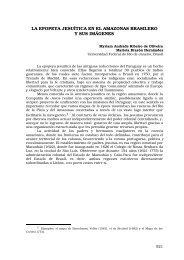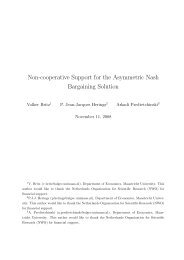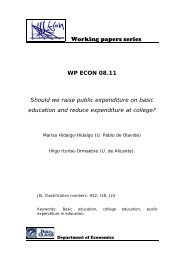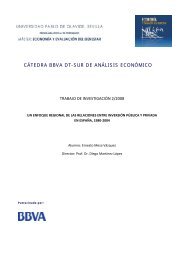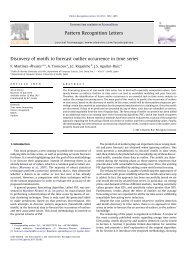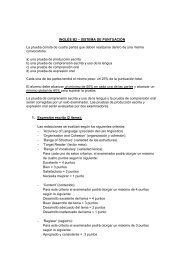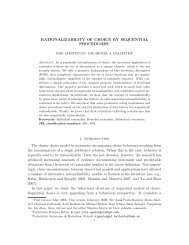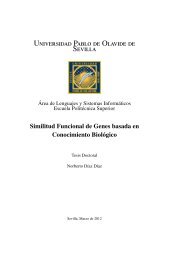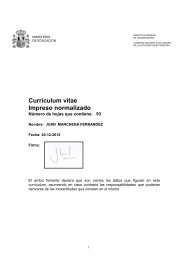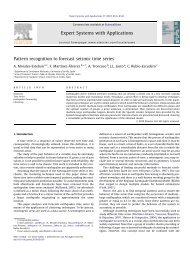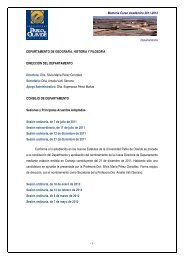On Ricardian Equivalence and Twin Divergence: The Spanish ...
On Ricardian Equivalence and Twin Divergence: The Spanish ...
On Ricardian Equivalence and Twin Divergence: The Spanish ...
You also want an ePaper? Increase the reach of your titles
YUMPU automatically turns print PDFs into web optimized ePapers that Google loves.
<strong>On</strong> <strong>Ricardian</strong> <strong>Equivalence</strong> <strong>and</strong> <strong>Twin</strong> <strong>Divergence</strong>:<strong>The</strong> <strong>Spanish</strong> Experience in the 2009 Crisis ∗M. Cardoso a <strong>and</strong> R. Doménech a,ba BBVA Economic Research Departmentb University of Valencia, SpainPreliminary <strong>and</strong> incomplete. November 23, 2008.AbstractDuring the current economic crisis in the <strong>Spanish</strong> economy, households are increasing very quicklytheir saving rate, the government budget has changed from surplus to a huge deficit <strong>and</strong> the currentaccount deficit is adjusting rapidly. In this paper we explore some possible explanations of thisevidence. Using a DGE model for the <strong>Spanish</strong> economy, we find that expansionary fiscal policieshave only small negative effects on the current account, even assuming a large proportion of non-<strong>Ricardian</strong> consumers. <strong>The</strong>refore, the current negative correlation between the government balancebudget <strong>and</strong> the current account, or twin divergence, represents a departure from traditional modelsthat either emphasize the presence of <strong>Ricardian</strong> equivalence or that completely ignore it. Alternativeexplanations for the strong change in consumption <strong>and</strong> saving patterns within the economy (outputloss, deleveraging, uncertainty), seem like better c<strong>and</strong>idates to explain the twin divergence.Keywords: <strong>Ricardian</strong> equivalence, current account, government budget deficit.JEL Classification: F32, F31, E62, F41, C32.1. IntroductionIn 2007 the <strong>Spanish</strong> economy exhibited a large current account deficit (10% of GDP), apublic budget surplus (2.2% of GDP), <strong>and</strong> a relatively low households saving rate (6.5% ofGDP), at least compared with their investment rate (almost 10% of GDP). However, withthe current economic crisis, the situation has changed dramatically, as Figures 1, 2 <strong>and</strong>∗ This paper has been prepared for the ECFIN Workshop on External imbalances <strong>and</strong> public finances in theEU, Brussels, 27 November 2009. <strong>The</strong> views expressed herein are the sole responsibility of the authors <strong>and</strong> do notreflect the opinions of their institutions. R. Doménech also thank the support of CICYT grant ECO2008-04669.
ON RICARDIAN EQUIVALENCE AND TWIN DIVERGENCE IN SPAIN 312.011.010.09.08.07.06.0Households, savings <strong>and</strong> investment% of GDP13.012.011.010.09.08.07.06.05.04.019871988198919901991199219931994199519961997199819992000200120022003200420052006200720082009 (p)Source: BBVA ERDSavingsInvestment5.04.0Figure 1: Households saving <strong>and</strong> investment rates (in percentage of GDP), Spain, 1995-2009.Figure 2: General Government Balance (in percentage of GDP), Spain, 1995-2009.
ON RICARDIAN EQUIVALENCE AND TWIN DIVERGENCE IN SPAIN 410.05.0Spain, Net Borrowing <strong>and</strong> Lending by sectorsAs a percentage of GDPTotal economy (rigth)10.05.00.05.010.00.05.015.020.0198619871988198919901991199219931994199519961997199819992000200120022003200420052006200720082009Source: BBVA ERDGeneral GovernmentFinancial InstitutionsNon Financial CorporationHouseholds(p) Forecast10.015.0Figure 3: Current Account (in percentage of GDP), Spain, 1986-2009.motivated by precautionary saving, in response to the greater uncertainty <strong>and</strong> the highunemployment rate (17,4% in the first quarter of 2009), <strong>and</strong> the desire of reducing theirlevels of debt, after the dramatic fall in their wealth <strong>and</strong> the expectations of future higherreal interest rates, as a consequence of the international finance turmoil. Given these explanations,although this evidence is observational equivalent to <strong>Ricardian</strong> equivalence,it seems that only a fraction of the increase in households saving rate is explained by thelarge current deficit in government’s budget. In fact, our results show that private agentsonly compensate partially the effects of fiscal policies on the saving rate. <strong>The</strong>refore, at thecurrent moment, the emphasis on future fiscal consolidation should be based more on thesustainability of government debt than on the effects on external imbalances. Accordingto these results, the current facts of the <strong>Spanish</strong> economy could be appropriately explainedby the presence of a large negative output shock as suggested by Kim <strong>and</strong> Roubini (2008)for the US, that has been tried to be counteracted with a large positive fiscal stimulus implementedby the <strong>Spanish</strong> Governemnt.<strong>The</strong> structure of this paper is the following, In Section 2 we present the generalequilibrium model for the <strong>Spanish</strong> economy that we use for economic policy evaluation.In Section 3 we analyse the effects of three different temporary fiscal policies: an increaseof public consumption, an increase in public investment <strong>and</strong> a reduction of the labourincome tax rate. In this section we discuss also the sensitivity of our results to changes insome crucial parameters. Finally, Section 4 presents the main conclusions.
ON RICARDIAN EQUIVALENCE AND TWIN DIVERGENCE IN SPAIN 52. <strong>The</strong>oretical frameworkIn this paper we use we use REMS, a Rational Expectations Model of the <strong>Spanish</strong> economydesigned by Boscá et al (2007), to analyse the effects of expansionary fiscal policies..REMS is a decentralized, small open economy model, where households, firms, policymakers<strong>and</strong> the external sector actively interact each period by trading one final good,two financial assets <strong>and</strong> three production factors 2 . In order to produce gross output, firmsemploy physical capital (public <strong>and</strong> private), labour <strong>and</strong> an intermediate input (energy).While private physical capital <strong>and</strong> energy are exchanged in a context of perfect competition,the labour market is not Walrasian. Households possess the available productionfactors. <strong>The</strong>y also own all the firms operating in the economy. In such a scenario, eachrepresentative household rents physical capital <strong>and</strong> labour services out to firms, for whichthey are paid income in the form of interest <strong>and</strong> wages. New jobs are created after investingin search activities. <strong>The</strong> fact that exchange in the labour market is resource <strong>and</strong>time-consuming generates a monopoly rent associated with each job match. It is assumedthat the worker <strong>and</strong> the firm bargain over these monopoly rents in Nash fashion.Each period the government faces a budget constraint where expenditure items arefinanced by means of public debt <strong>and</strong> various distortionary taxes. Intertemporal sustainabilityof fiscal balance is ensured by a conventional policy reaction function, whereby alump-sum tax transfer responds to the deviation of the debt to GDP ratio from its longtermtarget level.Monetary policy is geared by the European Central Bank (ECB) by means of interestrates movements, which target EMU inflation in which the weight of the <strong>Spanish</strong> economyis approximately 10 per cent.Each household is made up of working-age agents who may be active or inactive.In turn, active workers participating in the labour market may either be employed or unemployed.If unemployed, agents are actively searching for a job. Firms’ investment invacant posts is endogenously determined <strong>and</strong> so are job inflows. Finally, job destructionis taken as exogenous.2.1 HouseholdsFollowing Galí et al. (2007), liquidity-constrained consumers are incorporated into thest<strong>and</strong>ard Keynesian model. <strong>The</strong>re are two types of representative households. <strong>On</strong>e representativehousehold enjoys unlimited access to capital markets, so its members substituteconsumption intertemporally in response to changes in interest rates. We will refer to thesehouseholds as "<strong>Ricardian</strong> or optimizing consumers". Another representative household2 In this section we will present a brief description of the main characteristics of the model. For a completeaccount of the model, see Boscá et. al (2007).
ON RICARDIAN EQUIVALENCE AND TWIN DIVERGENCE IN SPAIN 6does not have access to capital markets, so its members can only consume out of currentlabour income. We will refer to these liquidity-constrained consumers as "rule-of-thumb(RoT) consumers".Both types of households maximize intertemporal utility by selecting streams ofconsumption <strong>and</strong> leisure. Household members may be either employed or unemployed,but are able to fully insure each other against fluctuations in employment, as in Andolfatto(1996) or Merz (1995). For the sake of simplicity, we assume that only optimizingconsumers hold money balances, as well as foreign <strong>and</strong> domestic bonds. However, taxesare levied on both <strong>Ricardian</strong> <strong>and</strong> the liquidity-constrained consumers.Optimizing households<strong>Ricardian</strong> households face the following maximization programme:maxc t ,n t ,j t ,k t,bt o,bo,emut ,m o t∞E t ∑ βln t c o t − hc o t−1 + no (T − lt−1 φ 1t ) 1−η1+ (1 − n o t−11 − η)φ (T − l 2t ) 1−η2+ χ1 − η m ln (m o t )t=0subject to r t (1 − τ k t ) + τk t δ k o t−1 + w t 1 − τ l t−(1 + τ c t )co tm o t−11+π c tP c tP t− Pi tP tj o tn o t−1 l 1t + rr t s 1 − n o t−1 l2t + 1 − τ l t g st − trh t ++ 1 + rt−1 n b ot−11+π c + (1 + r emu t−1t1+π c t 1 + φ 2− γ A γ Nm o t + bo t + bo,emu tφbt= 0 j otk o t−1t−1 ) bo,emu(1)(2)γ A γ N k o t = j o t + (1 − δ)k o t−1 (3)γ N n o t = (1 − σ)n o t−1 + ρw t s(1 − no t−1 ) (4)All variables in the maximisation problem above are stationary 3 . In our notation, variablesindexed by r <strong>and</strong> o respectively denote RoT <strong>and</strong> optimizing households. Non-indexedvariables apply indistinctly to both types of households. Thus, c o t ,no t−1 <strong>and</strong> s(1 − no t−1 )represent, consumption, the employment rate <strong>and</strong> the unemployment rate of <strong>Ricardian</strong>households. s is the share of the non-employed searching for a job, which is assumed to beexogenous. 4 T, l 1t <strong>and</strong> l 2t are the time endowment, hours worked per employee, <strong>and</strong> hours3 Thus, variables are expressed in efficiency units per persons of a working age.4 For simplicity, we assume that the leisure utility of the unemployed searching for a job is the same as for the
ON RICARDIAN EQUIVALENCE AND TWIN DIVERGENCE IN SPAIN 7devoted to job searching by the unemployed. Note that, while the household decides overl 1t , the same cannot be said of l 2t : time devoted to job searching is assumed to be a functionof overall economic activity, so that individual households take it as given 5 .Several parameters are presented in the utility function of <strong>Ricardian</strong> households.Future utility is discounted at a rate of β ∈ (0, 1). <strong>The</strong> parameter −η 1 measures the negativeof the Frisch elasticity of labour supply. As consumption is subject to habits, the parameterh takes a positive value. In general φ 1 ̸= φ 2, i.e., the subjective value of leisure imputedby workers may vary across employment statuses. For simplicity, we adopt the money-inthe-utilityfunction approach to incorporate money into the model.Maximization of (1) is constrained as follows. First, the budget constraint (2) describesthe various sources <strong>and</strong> uses of income. <strong>The</strong> term w t1 − τ l n o t−1 l 1t captures netlabour income earned by the fraction of employed workers, where w t st<strong>and</strong>s for hourlyreal wages. <strong>The</strong> product rr t w t1 − τ l s 1 − n o t−1l2t measures unemployment benefitsaccruing to the unemployed, where rr t denotes the (exogenous) replacement rate of theunemployment subsidy to the market wage. <strong>The</strong>re are four assets in the economy, namelyprivate physical capital (k o t ), domestic <strong>and</strong> Euro-zone bonds (bo t <strong>and</strong> bow t ) <strong>and</strong> money balances(m o t ). All assets are owned by <strong>Ricardian</strong> households. Barring money, the remainingassets yield some remuneration. Net return on capital is captured by r t k o t−1 (1 − τk ) +τ k δk o t−1 , where r t represents the gross return on physical capital. Note that depreciation istax-deductible as reflected in τ k δk o t−1. Interest payments on domestic <strong>and</strong> foreign debt arerespectively captured by rt−1n bt−1o1+π c , <strong>and</strong> r emu bt−1owt t−1 1+π c , where r n <strong>and</strong> r emu represent the nominaltinterest rates on domestic <strong>and</strong> EMU bonds, which may differ because of a risk premium.<strong>The</strong> other two expenditure categories are lump-sum transfers, trh t , <strong>and</strong> other governmenttransfers, g st .Total revenues can either be invested in private capital or spent on consumption.<strong>The</strong> household’s consumption <strong>and</strong> investment are respectively given by (1 + τ c ) Pc tP tc o t <strong>and</strong>Pti P tjto 1 + φ jt2 k, where τ c is the consumption income tax. Note that total investmentt−1 outlays are affected by the increasing marginal costs of installation jto 1 + φ jt2 k. Also,t−1the presence in the model of the relative prices Pt c/P t <strong>and</strong> Pt i/P t implies that a distinctionis made between the three deflators of consumption, investment <strong>and</strong> aggregate output.<strong>The</strong> remaining constraints faced by <strong>Ricardian</strong> households concern the laws of motionfor capital <strong>and</strong> employment. Each period the private capital stock k o t depreciates at theexogenous rate δ <strong>and</strong> is accumulated through investment, jt o . Thus, it evolves accordingnon-active.5 We assume for empirical reasons that the search effort undertaken by unemployed workers varies along thecycle depending positively on the GDP growth rate.
ON RICARDIAN EQUIVALENCE AND TWIN DIVERGENCE IN SPAIN 9cation of capital over time:q t = 1 + πc t+11 + r n t"r t+1 (1 − τ k t+1 ) + τk t+1 δ + φ 2j 2 t+1k 2 t+ q t+1 (1 − δ)where q t is Tobin’s q, that is obtained from the first order condition for investment:"!#q t = Pi tjto 1 + φP tk o t−1#(9)(10)Deriving the Lagrangian with respect to foreign debt b o,emutwith (7) yields<strong>and</strong> combining with1 + r n t = φ bt(1 + r nwt ) (11)implying that the interest parity condition holds between domestic <strong>and</strong> EMU bonds to theextent that they are perfect substitutes. Note that (11) slightly differs from the st<strong>and</strong>arduncovered interest parity condition in that there is no risk associated with exchange ratemovements, as both domestic <strong>and</strong> foreign bonds are expressed in the same currency. Notethat the specification above assumes that <strong>Ricardian</strong> households incur in a risk premiumwhen buying foreign bonds (φ bt). Specifically, the risk premium is made up of a functionof net foreign asset holdings in the following wayln φ bt= −φ b(exp (b o,emut ) − 1) (12)Finally, it is easy to show that the first order condition for money can be rewrittenas a money dem<strong>and</strong> function by using the current-value shadow price of income (6)m o t = 1γ A γ Nχ m (1 + τ c t) Pc tP t1 + r n tr n t1c o t −hco t−11− βhc o t+1 −hco t (13)Rule-of-thumb householdsRoT households do not benefit from access to capital markets <strong>and</strong> also do not hold money,so they face the following maximization programme 6 :maxc r t ,nr t∞E t ∑ βln t c r t − hc r t−1 + nr (T − lt−1 φ 1t ) 1−η1+ (1 − n r t−11 − η)φ (T − l 2t ) 1−η21 − ηt=06 Alternatively, Coenen, McAdam <strong>and</strong> Straub (2008) allow these households to smooth consumption by changingmoney holdings.
ON RICARDIAN EQUIVALENCE AND TWIN DIVERGENCE IN SPAIN 10subject to the law of motion of employment (4) <strong>and</strong> the specific liquidity constraint wherebyeach period’s consumption expenditure must be equal to current labour income <strong>and</strong> governmenttransfers, as reflected in:w t1 − τ l tn r t−1 l 1t + rr t s 1 − n r t−1 l2t + gst 1 − τ l t − trh t − (1 + τ c t)c r Ptct = 0 (14)P tγ N n r t = (1 − σ)n r t−1 + ρw t s(1 − nr t−1 ) (15)Note that RoT consumers do not save <strong>and</strong>, as a result, they do not hold any assets. Thisfeature of RoT consumers considerably simplifies the solution to the optimization programme,which is characterized by the following equations concerning optimal consumption,c r t , <strong>and</strong> optimal employment, nr t :λ r 1t = 1(P c t /P t)c r t (1 + τc t ) 1c r t − hcr t−1!h− βc r t+1 − hcr t(16)γ N λ r 3t = βE t(φ 1(T−l 1t+1 ) 1−η1−η(T−l− φ 2t ) 1−η2 1−η+ λ1t+1 r w t+1 1 − τ ll+1(1 − σ) − χ1 ρ w t+1+λ r 3t+1(l 1t+1 − rr t+1 sl 2t ))(17)AggregationAggregate consumption <strong>and</strong> employment can be defined as a weighted average of thecorresponding variables for each household type 7 :c t = (1 − λ r ) c o t + λ r c r t (18)n t = (1 − λ r ) n o t + λ r n r t (19)For the variables that exclusively concern <strong>Ricardian</strong> households, aggregation is merelyperformed as:k t = (1 − λ r ) k o t (20)7 1 − λ r <strong>and</strong> λ r denote the constant fractions in the working-age population of <strong>Ricardian</strong> <strong>and</strong> RoT consumers.
ON RICARDIAN EQUIVALENCE AND TWIN DIVERGENCE IN SPAIN 11j t = (1 − λ r ) j o t (21)b t = (1 − λ r ) b o t (22)b emut= (1 − λ r ) b oemut (23)m t = (1 − λ r ) m o t (24)2.2 Factor dem<strong>and</strong>sProduction in the economy takes place at two different levels. At the lower level, an infinitenumber of monopolistically competing firms produce differentiated intermediategoods (y i ), which imperfectly substitute each other in the production of the final good.<strong>The</strong>se differentiated goods are then aggregated by competitive retailers into a final domesticgood (y) using a CES aggregator.Intermediate producers solve a two-stage problem. In the first stage, each firm facesa cost minimization problem which results in optimal dem<strong>and</strong>s for production factors.When choosing optimal streams of capital, energy, employment <strong>and</strong> vacancies intermediateproducers set prices by varying the mark-up according to dem<strong>and</strong> conditions. Varietyproducer i ∈ (0, 1) uses three inputs: a composite input of private capital <strong>and</strong> energy,labour <strong>and</strong> public capital, so that technological possibilities are given by:y it = z it hak −ρit−1i − 1 1−α ρ+ (1 − a)e−ρit(n it−1 l i1t ) α k p ζit−1(25)where all variables are scaled by the trend component of total factor productivity <strong>and</strong> z trepresents a transitory technology shock. Each variety producer rents physical capital,k t−1 , <strong>and</strong> labour services, n t−1 l 1t , from households, <strong>and</strong> uses public capital services, k p t−1 ,provided by the government. Intermediate energy inputs e t can be either imported fromabroad or produced at home. <strong>The</strong> technical elasticity of substitution between private capital<strong>and</strong> energy is given by1+ρ 1 . α ∈ (0, 1) is a distribution parameter: it determines relativefactor shares in the steady state. Furthermore, it is convenient to denote capital services
ON RICARDIAN EQUIVALENCE AND TWIN DIVERGENCE IN SPAIN 12by k iet as:k iet =hak −ρit−1i − 1ρ+ (1 − a)e−ρit(26)Factor dem<strong>and</strong>s are obtained by solving the cost minimization problem faced byeach variety producer (we drop the industry index i when no confusion arises)subject to∞min E tk t ,n t ,v t ,e t∑ β t λo 1t+1λ o r t k t−1 + w t (1 + τ sc ) n t−1 l 1t + κ v v t + Pe te t (1 + τ e )t=0 1tP t(27)y t = z it hak −ρt−1i − 1 1−α ρ+ (1 − a)e−ρt(n t−1 l 1t ) α k p ζt−1 − κ f (28)γ N n t = (1 − σ)n t−1 + ρ f t v t (29)where, in accordance with the ownership structure of the economy, future profits are discountedat the household relevant rate β. κ v captures recruiting costs per vacancy, κ f is anentry cost which ensures that extraordinary profits vanish in imperfectly-competitive equilibrium,τ sc is the social security tax rate levied on gross wages 8 , <strong>and</strong> ρ f tis the probabilitythat a vacancy will be filled in any given period t. It is worth noting that the probability offilling a vacant post ρ f tis exogenous from the firm’s perspective. However, from the perspectiveof the overall economy, this probability is endogenously determined according tothe following Cobb-Douglas matching function:ρ w t (1 − n t−1) = ρ f t v t = χ 1 v χ 2t [s (1 − n t−1 ) l 2t ] 1−χ 2(30)Under the assumption of symmetry, the solution to the optimization programmeabove generates the following first order conditions for private capital, employment, energy<strong>and</strong> the number of vacancies y 1+ρr t+1 = (1 − α)mc t+1 ket+1t+1 a(31)k et+1 k tγ N λ nd λ o 1t+1 yt = βE tλ1to αmc t+1t+1 − wn t+1 (1 + τ sct+1 )l 1t+1 + λ ndt+1 (1 − σ) t(32)8 Note that, in our specification, firms bear the statutory incidence of social security contributions.
ON RICARDIAN EQUIVALENCE AND TWIN DIVERGENCE IN SPAIN 13(1 − α)(1 − a)mc ty tke t−1 kete t 1+ρ= Pe tP t(1 + τ e t) (33)κ v v t = λ ndt χ 1 χ 2 v χ 2t(s(1 − n t−1 )l 2t ) 1−χ 2 (34)where the real marginal cost (mc t ) corresponds to the Lagrange multiplier associated withthe first restriction (28), whereas λ ndt denotes the Lagrange multiplier associated with thesecond restriction (29).2.3 Pricing behavior of intermediate firms: the New Phillips curveIntermediate firms enjoy market power <strong>and</strong> are, therefore, price setters. Each intermediatefirm produces a variety y i <strong>and</strong> faces a downward-sloping dem<strong>and</strong> curve that takes theform below:y it = y tPitP t −ε(35)wherePitis the relative price of variety y i , ε can be expressed in terms of the elasticityof substitution between intermediate goods, ς ≥ 0, as ε = (1 + ς) /ς, <strong>and</strong> y t represents theproduction of the final product as defined byP t Z 1y t =01+ς Z 1y 1/1+ςitdi<strong>and</strong> P t = P − 1 −ςςitdi(36)0Variety producers act as monopolists <strong>and</strong> choose prices when allowed. We use thewell-known Calvo hypothesis (Calvo, 1983), thereby assuming some overlapping adjustmentin prices. Those firms that do not reset their prices optimally at a given date adjustthem according to a simple indexation rule to catch up with lagged inflation. Thus, eachperiod a proportion θ of firms simply set P it = (1 + π t−1 ) κ P it−1 (with κ representing thedegree of indexation), while only a measure 1 − θ of firms set their prices, eP it , to maximizethe present value of expected profits. Consequently, 1 − θ represents the probabilityof adjusting prices each period, whereas θ can be interpreted as a measure of price rigidity.Thus, the maximization problem of the representative variety producer generates a firstorder condition given by:eP it =hiε ∑ ∞ j=0 (βθ)j E t ρ it,t+jP ε+1t+j mc it+jy t+j π −εt+jhε − 1∑ ∞ j=0 (βθ)j E t ρ it,t+jPt+j ε y t+jπ (1−ε) i (37)t+j
ON RICARDIAN EQUIVALENCE AND TWIN DIVERGENCE IN SPAIN 14where ρ t,t+jis a price kernel which captures the marginal utility of an additional unit ofprofits accruing to optimizing households at t + j. <strong>The</strong> corresponding aggregate priceindex is equal toP t =hθ π κ t−1 P i 1−εt−1 + (1 − θ) eP t1−ε11−εAs is st<strong>and</strong>ard in the literature 9 , equation (38) can be used to obtain an expressionfor aggregate inflation in the form below:π t =β1 + κβ E tπ t+1 +(1 − βθ) (1 − θ)cmc t +θ(1 + κβ)(38)κ1 + κβ π t−1 (39)where cmc t measures the deviation of the firm’s marginal cost from the steady state, i.e.,mc t = ε−1ε(1 + cmc t ). Equation (39) is known in the literature as the New Phillips curve. Itparticipates of the conventional Phillips-curve philosophy that inflation is influenced byactivity in the short run, emphasizing real marginal costs as the relevant variable to theinflation process, which is seen as a forward-looking phenomenon. <strong>The</strong> reduced form ofthe New Phillips curve can be simplified as:π t = β f E t π t+1 + λ cmc t + β b π t−1 (40)2.4 Trade in the labour market: the labour contract<strong>The</strong> key departure of search models from the competitive paradigm is that trading in thelabour market is subject to transaction costs. Each period, the unemployed engage insearch activities in order to find vacant posts spread over the economy. Costly search inthe labour market implies that there are simultaneous inflows into <strong>and</strong> outflows out of thestate of employment, so that an increase (reduction) in the stock of unemployment resultsfrom the predominance of job destruction (creation) over job creation (destruction). Stableunemployment occurs whenever inflows <strong>and</strong> outflows cancel out one another, i.e.,ρ f t v t = ρ w t (1 − n t−1) = χ 1 v χ 2t [(1 − n t−1 ) l 2t ] 1−χ 2= (1 − σ)n t−1 (41)Because it takes time (for households) <strong>and</strong> real resources (for firms) to make profitablecontacts, some pure economic rent emerges with each new job, which is equal tothe sum of the expected transaction (search) costs the firm <strong>and</strong> the worker will further incurif they refuse to match. <strong>The</strong> emergence of such rent gives rise to a bilateral monopolyframework.9 See, for example, Galí, Gertler <strong>and</strong> López-Salido (2001).
ON RICARDIAN EQUIVALENCE AND TWIN DIVERGENCE IN SPAIN 15<strong>On</strong>ce a representative job-seeking worker <strong>and</strong> vacancy-offering firm match they negotiatea labour contract in hours <strong>and</strong> wages. We therefore stick to the efficient-bargaininghypothesis instead of the right-to-manage hypothesis (see Trigari, 2006, for further detailsabout the implications of these two different hypotheses).Several wage <strong>and</strong> hours determination schemes can be applied to a bilateral monopolyframework. In particular, we will assume that firms <strong>and</strong> workers negotiate by means of aNash bargain, so the outcome of the bargaining process maximizes the productmax λ r λr 3tw t+1 , l 1t+1 λ1tr+ (1 − λ r ) λo λw 3tλ1toλ ndt (1−λ w )(42)where λ w ∈ (0, 1) reflects the worker’s bargaining power. <strong>The</strong> first term in brackets representsthe representative worker surplus while the second is the firm surplus. More specifically,λ3t o /λo 1t <strong>and</strong> λr 3t /λr 1t respectively denote the earning premium (in terms of consumption)of employment over unemployment for a <strong>Ricardian</strong> <strong>and</strong> a RoT worker. Similarly, λ ndtrepresents the profit premium of a filled over an unfilled vacancy for the representativefirm. Note that this bargaining scheme features the same wage for all workers, irrespectiveof whether they are <strong>Ricardian</strong> or RoT.Optimal real wage <strong>and</strong> hours worked (42) satisfy the following conditions (seeBoscá et. al, 2007 for further details):(1 + τ sct )w t l 1t =λ wh1 − (1 − λ w ) rr t s l 2t(1 − λ w ) (1 + τsc+ hit )1 − (1 − λ w ) rr t s l 2t 1 − τ l 64l t1t2"il 1t ˜λ3tλ 1t−1y tαmc t + (1 − σ) κ vn t−1˜λ1tλ 1t−1 [ρ w t− (1 − σ)] −#ρ f t ˜1λ 1t−13 u t75λ 1t−1˜λ1t(43)!˜λ1ty tαmc t =λ 1t−1 n t−1 l 1,t˜1!(1 + τsct )λ 1t−1 1 − τ l φ 1[1 − l 1t ] −η (44)twhere:u t = Pc tc t (1 + τ c (T − lPt)φ 1t+1 ) 1−η1t 1 − η! ˜λ1t=λ 1t−1λ r λ1trλ1t−1r+ (1 − λ r )(T − l− 2t ) 1−η φ 21 − ηλ o 1tλ o 1t−1(45)
ON RICARDIAN EQUIVALENCE AND TWIN DIVERGENCE IN SPAIN 16! ˜1= λ r 1λ 1t−1 λ1t−1r + (1 − λ r )1λ o 1t−1! ˜λ3t=λ 1t−1λ r λ3trλ1t−1r+ (1 − λ r )λ o 3tλ o 1t−1Unlike the Walrasian outcome, the wage prevailing in the search equilibrium is at somepoint between the marginal rate of substitution of consumption for leisure <strong>and</strong> the marginalproductivity of labour, depending on worker bargaining power λ w . Put differently,the wage is a weighted average between the highest feasible wage (i.e., the marginal productivityof labour plus the cost of posting a vacancy corrected by the probability that thevacancy will be filled) <strong>and</strong> the lowest acceptable wage (i.e., the reservation wage as givenby the disutility from work corrected by the probability of finding a job). Consequently,the equilibrium wage depends on a number of policy parameters <strong>and</strong> institutional variablesdescribing labour market performance. Notice that when λ r = 0, all consumers are<strong>Ricardian</strong>, <strong>and</strong>, therefore, the solutions for the wage rate <strong>and</strong> hours simplify to the st<strong>and</strong>ardones.2.5 GovernmentEach period the government decides the size <strong>and</strong> composition of public expenditure <strong>and</strong>the mix of taxes <strong>and</strong> new debt holdings required to finance total outlays. It is assumedthat government purchases of goods <strong>and</strong> services (g c t ) <strong>and</strong> public investment (gi t ) followan exogenously given pattern. Conversely, interest payments on government bonds (1 +r t )b t−1 , unemployment benefits g ut (1 − n t−1 ) , <strong>and</strong> government social transfers g st areassumed to be endogenous. <strong>The</strong> two latter expenditure categories are given byg ut = rr t w t (46)g st = tr t gdp t (47)whereby g ut <strong>and</strong> g st are made proportional to the level of real wages, w t ,<strong>and</strong> activity, gdp t ,through rr t <strong>and</strong> tr t .Government expenditure is financed by direct taxation, levied on either labour income(personal labour income tax, τ l t, <strong>and</strong> social security contributions, τsct) or capital income(τ k t ), as well as indirect taxation, represented by consumption (τc t) <strong>and</strong> energy taxes
ON RICARDIAN EQUIVALENCE AND TWIN DIVERGENCE IN SPAIN 17(τ e t). Government revenues are therefore given byt t = (τ l t + τ sct )w t (n t−1 l 1t ) + τ k t (r t − δ) k t−1 (48)+τ c Ptct c t + τ e Ptet e t + trh t + τ lP t Ptrrw t (1 − n t−1 )l 2t + τ l tg sttwhere trh t st<strong>and</strong>s for lump-sum transfers as defined below.Each period total receipts <strong>and</strong> outlays are made consistent by means of the government’sbudget constraintγ A γ N b t = g c t + g i t + g ut (1 − n t−1 ) + g st − t t + (1 + rn t )1 + π tb t−1 (49)Equation (49) reflects that the gap between total receipts <strong>and</strong> outlays is financed by variationsin lump-sum transfers to households, trh t (which enter the fiscal budget rule throughthe term t t ), <strong>and</strong>/or the issue of domestic bonds (b t − b t−1 ). As it st<strong>and</strong>s, equation (49) hasan intertemporal dynamic nature. Note that government income from seniorage is nil.Dynamic sustainability of public debt requires the introduction of a debt rule thatmakes one or several fiscal categories an instrument for debt stabilization. In order toenforce the government’s intertemporal budget constraint, the following fiscal policy reactionfunction is imposedtrh t = trh t−1 + ψ 1"b tgdp t− # bbt+ ψgdp 2−b t−1gdp t gdp t−1 where bgdpis the long-run target for the debt-to-GDP ratio <strong>and</strong> ψ 1> 0 captures thespeed of adjustment from the current ratio towards the desired target. <strong>The</strong> value of ψ 2> 0will be chosen to ensure a smooth adjustment of actual debt towards its steady-state level.Note that while in the baseline specification debt stabilization is accomplished throughvariations in lump-sum transfers, nothing precludes other receipt or spending categoriesfrom playing this role.Government investment augments public capital, which in turn depreciates at therate δ p <strong>and</strong> thus follows the law of motion:(50)γ A γ N k p t= g i t + (1 − δ p )k p t−1(51)2.6 Monetary policyMonetary policy is geared by the European Central Bank (ECB), which targets EMU inflationby means of movements in interest rates. More specifically, short-term interest rates
ON RICARDIAN EQUIVALENCE AND TWIN DIVERGENCE IN SPAIN 18are governed by the following reaction functionln 1 + remu t1 + r emu = ρr ln 1 + remu t−11 + r emu + ρπ (1 − ρ r ) ln(π emut− π emu ) + ρ y (1 − ρ r ) ln ∆ ln y emut (52)where all the variables indexed by emu refer to EMU aggregates. Thus, rtemu <strong>and</strong> π emut arethe Euro-zone nominal short-term interest rate <strong>and</strong> consumption price deflator (to whichthe <strong>Spanish</strong> economy contributes according to its relative size), <strong>and</strong> ∆ ln y emut measuresthe deviation of GDP growth from its trend. As explained in Woodford (2003), (52) is theoptimal outcome of a rational central bank facing <strong>and</strong> objective function under generalequilibrium conditions.Finally, the disappearance of national currencies since the inception of the monetaryunion means that the intra-euro-area real exchange rate is simply given by the ratio ofrelative prices between the domestic economy <strong>and</strong> the remaining EMU members, so realappreciation/depreciation developments are driven by the inflation differential vis-à-visthe euro area:rer t+1rer t= 1 + πemu t+11 + π t+1(53)2.7 <strong>The</strong> External Sector<strong>The</strong> small open economy hypothesis adopted in REMS implies that world prices <strong>and</strong>world dem<strong>and</strong> are taken as given. It also means that feedback linkages between the domesticeconomy, EMU <strong>and</strong> the rest of the world are ignored. Another simplifying assumptionconcerns the nature of final <strong>and</strong> intermediate goods produced at home, which are allconsidered to be tradable.<strong>The</strong> allocation of consumption <strong>and</strong> investment between domestic <strong>and</strong> foreign produced goodsLet us think of aggregate consumption (investment) as a composite basket of home <strong>and</strong>foreign produced goods. <strong>The</strong>re is a representative consumption (investment) distributorwhose role is to determine the share of aggregate consumption (investment) to be satisfiedwith home produced goods c h (i h ) <strong>and</strong> foreign imported goods c f (i f ). This is carried outon the basis of CES technology:c t = (1 − ω ct ) 1σc−1σcσccht+ ω ct1σc σc−1σcc f t! σcσc−1(54)
ON RICARDIAN EQUIVALENCE AND TWIN DIVERGENCE IN SPAIN 19i t =!σ(1 − ω it ) 1 σ i −11 σ σ i −1 iσ i −1σ i i iht+ ω σiσit i i f t(55)where σ c (σ i ) is the consumption (investment) elasticity of substitution between domestic<strong>and</strong> foreign goods.Each period, the representative consumption distributor chooses c ht <strong>and</strong> c f t so as tominimize production costs subject to the technological constraint given by (54). <strong>The</strong> solutionof this problem provides the optimal allocation of aggregate consumption betweendomestic <strong>and</strong> foreign goods, c ht <strong>and</strong> c f t : −σc Ptc ht = (1 − ω c )Ptc c t (56)c f t = ω c PmtP c t −σcc t (57)where P t <strong>and</strong> Ptm are respectively the prices of home <strong>and</strong> foreign produced goods. Ptcrepresents both the price of the consumption good borne by households <strong>and</strong> the shadowcost of production borne by the aggregator.Proceeding in the same manner as with the investment distributor problem, similarexpressions can be obtained regarding the optimal allocation of aggregate investmentbetween domestic <strong>and</strong> foreign goods, i ht <strong>and</strong> i f ti ht = (1 − ω i )P tP i t! −σii t (58)i f t = ω iPtm Pti! −σii t (59)Price formationIn the preceding analysis, the price of domestically produced consumption <strong>and</strong> investmentgoods is equal to the GDP deflator, P t . In order to obtain the consumption pricedeflator, one needs to further incorporate the dem<strong>and</strong> schedules provided by (56) <strong>and</strong> (57)for home <strong>and</strong> foreign consumption goods into the cost of producing one unit of aggregateconsumption goods (P t c ht + P m t c f t ). Bearing in mind that the production cost per
ON RICARDIAN EQUIVALENCE AND TWIN DIVERGENCE IN SPAIN 20unit equates to the price of production, it is straightforward to express the consumption(investment) price deflator as a function of the GDP <strong>and</strong> import deflatorsP c t =(1 − ω ct )P 1−σ ct+ ω ct P m1−σ 1c 1−σct(60)P i t =(1 − ω it )P 1−σ it 1+ ω it P m1−σ it1−σ i (61)<strong>The</strong> exogenous world price is a weighted average calculated on the basis of finalgood <strong>and</strong> intermediate good prices, PFM <strong>and</strong> P e , both expressed in terms of the domesticcurrency. Given the small open economy assumption, the relevant foreign price is definedas:P m t= eα e P e t + (1 − eα e )PFM t(62)where eα e st<strong>and</strong>s for the ratio of energy imports to overall imports.Let us consider that export prices charged by <strong>Spanish</strong> firms deviate from pricescharged by competitors in foreign markets, at least temporarily. This well-known pricingto-markethypothesis is consistent with a model of monopolistic competition among firmswhere each firm regards its influence on other firms as negligible. We may define the<strong>Spanish</strong> export price deflator asP x t= P (1−ptm)tPFM t ptm(63)where P x t is the export price deflator, PFM t is a competitors price index expressed in euros<strong>and</strong> the parameter ptm determines the extent to which there is pricing-to-market.Exports <strong>and</strong> ImportsAggregate imports include two final goods, foreign consumption <strong>and</strong> investment, <strong>and</strong> oneintermediate commodity, energy:im t = c f t + i f t + α e e t (64)where α e represents the ratio of energy imports over total energy consumption.Exports dem<strong>and</strong> can be defined in terms of aggregate consumption <strong>and</strong> investmentfrom abroad, y w t, <strong>and</strong> the ratio of the export price deflator to the competitors price index
ON RICARDIAN EQUIVALENCE AND TWIN DIVERGENCE IN SPAIN 21expressed in euros, P x t /PFM t: Pex t = stx x −σxty w t(65)PFM tPlugging (63) into (65) yields the exports dem<strong>and</strong> under the small open economyassumption <strong>and</strong> the pricing-to-market hypothesis:ex t = s x t PFMtP t (1−ptm)σxy w t(66)Stock-flow interaction between the current account balance <strong>and</strong> the accumulation of foreign assetsIn the model, the current account balance is defined as the trade balance plus interest ratereceipts/payments from net foreign assets:ca t = Px tex t − Pm tim t + (rtemu − π t ) bt−1 oemu(67)P t P tFollowing st<strong>and</strong>ard practice in the literature (see, for example, Obstfeld <strong>and</strong> Rogoff,1995, 1996), net foreign assets are regarded as a stock variable resulting from the accumulationof current account flows. This is illustrated by the following dynamic equation:γ A γ N b oemutφ bt=(1 + remu1 + π c tt )b oemut−1+ Px tP tex t − Pm tP tim t (68)(68) is obtained by combining the <strong>Ricardian</strong> households’ budget constraint (assuming azero net supply for domestic bonds <strong>and</strong> money), the government’s budget constraint <strong>and</strong>the economy’s aggregate resource constraint.2.8 Accounting identities in the economyGross output can be defined as the sum of (final) dem<strong>and</strong> components <strong>and</strong> the (intermediate)consumption of energy:y t = c ht + i ht + g t + Px tP tex t + κ v v t + Pe tP t(1 − α e )e t + κ f (69)whereas value added generated in the economy is given by:gdp t = y t − Pe tP te t − κ f − κ v v t (70)Note that, in accordance with previous definitions, c ht <strong>and</strong> i ht are equal to overall domestic
ON RICARDIAN EQUIVALENCE AND TWIN DIVERGENCE IN SPAIN 22consumption <strong>and</strong> investment minus consumption <strong>and</strong> investment goods imported fromabroad. Thus, c ht <strong>and</strong> i ht are consistent with the definitions above for gross output <strong>and</strong>value added.2.9 Model calibrationModel parameters have been fixed using a hybrid approach of calibration <strong>and</strong> estimation.Some parameter values are taken from different related DGE models. Several other parametersare calculated from the sample average counterpart of long-run conditions. <strong>The</strong>remaining parameters have been estimated on the basis of selected model’s equations.Altogether, these parameters produce a baseline solution that accurately resembles the behaviourof the <strong>Spanish</strong> economy over the last two decades.<strong>The</strong> data used in the calibration come from the REMSDB database. All series coverthe period 1985:3 2006:4. At the beginning of the sample, the third quarter of 1985 displaysadequate cyclical properties for most of the endogenous variables (see Puch <strong>and</strong> Lic<strong>and</strong>ro,1997, <strong>and</strong> Boscá et al, 2007b). Several variables included in the model have no directstatistical counterpart from official sources. Such variables include consumption <strong>and</strong> employmentof RoT <strong>and</strong> optimizing consumers, Lagrange multipliers, Tobin’s q, compositecapital stock, marginal cost <strong>and</strong> total factor productivity. In order to sidestep the lack ofdata availability affecting these variables, we use the model’s related behavioural equationsto compute them.Table 1 lists the values of parameters <strong>and</strong> exogenous variables. <strong>The</strong> implied steadystate values of the endogenous variables are given in Table 2 10 . Roughly speaking, thecalibration strategy follows a sequence in which one starts by setting the value of a numberof parameters which are subsequently used to obtain a measure of the level of totalfactor productivity. This makes it possible to express all variables in the model in termsof efficiency units. <strong>The</strong> remaining parameters are then fixed on the basis of the model’sequations with variables measured in efficiency units (see Boscá et. al., 2007 for furtherdetails).3. Fiscal policy <strong>and</strong> the current account3.1 A temporary increase of public consumptionWe first analyse the effects of a temporary but persistent increase of public consumptionupon the main macroeconomic variables in our model. <strong>The</strong> initial shock in public con-10 <strong>The</strong> model has been programmed in relative prices. This means that all prices are relative to the deflatorprice index, P t , <strong>and</strong> the real exchange rate is defined as rer t = PFM tP t.
ON RICARDIAN EQUIVALENCE AND TWIN DIVERGENCE IN SPAIN 23Table 1 − Parameter Valuesg 0.0905 l 2 0.2183 β b 0.5035 π emu 0.0000 τ c 0.1069 φ 1 2.9483 bgdp2.4000 T 1.3690τ l 0.1107 η 2.0000 rr 0.3832 λ w 0.4274τ k 0.2080 σ c 1.2063 τ e t 0.2000 ω i 0.1381tr 0.1381 φ b 0.0060 ψ 1 0.0100 σ i 0.9305τ sc 0.2215 φ 2 2.2389 ψ 2 0.2000 λ r 0.5000P e 0.8620 ρ 0.9571 σ x 1.3000 h 0.6000β 0.9908 a 0.9985 r emu 0.0158 α e 0.4980α 0.5938 χ m 0.1987 ζ 0.0600 eα e 0.1049δ 0.0141 mc 0.7961 γ A 1.0018 ω c 0.0930φ 5.5000 γ 1.7500 γ N 1.0047 κ f 0.2730κ v 1.4966 s 0.2600 δ p 0.0105 s x 0.0142σ 0.0180 ρ r 0.7500 ptm 0.5767 ρ w 0.7600χ 1 0.6115 λ 0.2006 ω c 0.0930 φ e 25.000χ 2 0.5725 β f 0.4965 y w 7.7855 ρ e 0.8500sumption is equivalent to 1 per cent of GDP (more than 5 per cent in terms of public consumption),similar to the size of the expansionary policies implemented through publicexpenditure in 2008 <strong>and</strong> 2009 by the <strong>Spanish</strong> government. 11 Figure 4 presents the impulseresponsefunctions of the main endogenous variables. <strong>The</strong> response of output is clearlypositive on impact <strong>and</strong> the short term multiplier is equal to 1.0. As expected, the responseof private consumption is also positive, due to the presence of rule-of-thumb consumer,since the consumption of optimizing households falls, given the negative wealth effects ofhigher government spending. <strong>The</strong> higher level of output is obtained with a higher levelof total hours worked (labor supply also rises with the negative wealth effect of optimizinghouseholds), which is accompanied with slightly greater real wages, in spite of theirrigidities. <strong>On</strong> the contrary, private investment decreases, reaching the lowest levels afterthree quarters. <strong>The</strong> fall of investment is driven by the fall in Tobin’s q.<strong>The</strong> increase in marginal costs also pushes the inflation rate up. Higher domesticprices as well as higher levels of output <strong>and</strong> private consumption cause an increase in importson impact. However, this increase of imports has a short life since imports are moresensitive to private investment, which falls from t + 1 to t + 3. <strong>The</strong> increase in domestic11 In particular, the law of movement of public consumption is given by:g c t = 0.9g c t−1 + 0.1gc + ε g twhere g c is the steady-state level of public consumption <strong>and</strong> ε g is the shock.
ON RICARDIAN EQUIVALENCE AND TWIN DIVERGENCE IN SPAIN 24b t 1.3951 i ht 0.0987b o t 1.3951 im t 0.1565Table 2 − Steady State˜λ1t+1λ 1t˜λ3t+1λ 1t1.0000 r t 0.03350.2539 r n t 0.0142c t 0.3192 j t 0.1582 λ3t o 0.1997 g st 0.0803c f t 0.0542 jt o 0.3163 λ3t r 1.4439 trh t 0.0067c ht 0.2659 k t 7.5943 λ ndt 0.4648 t t 0.2024c o t 0.3570 ke t 6.3208 λ1t o 2.6355 Ut n -1.258c r t 0.2814 k o t 15.189 λ1t r 3.3428 g ut 0.0600pe t 0.0477 l 1t 0.4487c tp 0.9734 tv t 0.0595rer t 0.8390 m t 2.6116 π t 0.0000 w t 1.2830ex t 0.1431 cmc t 0.0000 gdp t 0.5813 y t 0.9861bt w 0.0000 m o t 5.2232 π c t 0.0000 φ bt 1.0000bt ow 0.0000 n t 0.6102 p t0.9228 k p t 1.1131gt c 0.0905 n o t 0.6102p m tp t0.8267 l 2t 0.2183i t 0.1672 n r ptt 0.6102p 0.9037 tgt i 0.0173 i f1f t 0.0785 λ1t0.3393 q t 1.0285p i tprices also affects negatively foreign competitiveness, therefore inducing a reduction ofexports. As shown in Figure 4 the real exchange rate appreciates <strong>and</strong> the terms of trade(P x /P m ) increase. In spite of the higher inflation rate, nominal interest rate increases veryslightly, given the small weight of the <strong>Spanish</strong> economy in EMU inflation (around 10 percent). Finally, as expected, public debt increases, reaching its highest level seven quartersafter the shock, <strong>and</strong> then falls steadily as a result of the fiscal rule.A very interesting way of analysing the effects of the positive shock in public consumptionupon the external imbalances is given by Figure 5. In this figure we have representedthe absolute deviations of the savings, investment <strong>and</strong> public consumption, all inrelative terms with respect to GDP, from their steady-state levels (that is, x t − x). As wecan observe, the public consumption rate increases above 0.8 percentage points, <strong>and</strong> thesaving rate almost falls 0.6pp. In fact, private savings only compensate a 46.6 per cent ofthe increase of public consumption, on average over the first 20 quarters. <strong>The</strong>refore, thereis only partial <strong>Ricardian</strong> equivalence in our economy.However, the fall in the investment rate compensates partially the fall of the savingrate <strong>and</strong>, therefore, the increase in the current account deficit is very small: on impact isequal to 0.2pp of GDP, smaller than 1/4 of the increase in the public consumption rate. In
ON RICARDIAN EQUIVALENCE AND TWIN DIVERGENCE IN SPAIN 2520GDP C I10ImportsExports20 5 10 15 200.50Consumer price inf lationNominal interest rate0.50 5 10 15 2021010 5 10 15 2010.5Real wageTotal hours workedPublic debt00 5 10 15 2010 5 10 15 200.50.50Real exchange rateTerms of trade10 5 10 15 20420Real rental rate of capitalReal marginal cost20 5 10 15 2010500 5 10 15 20gFigure 4: Impulse-response functions after a temporary shock in public consumption.other words, although there is some evidence of twin deficits, only a small fraction of thegovernment budget deficit translates into a current account deficit. Surprisingly, despitethe large differences between SIGMA <strong>and</strong> REMS, our results are very similar to those obtainedby Erceg, Guerrieri <strong>and</strong> Gust (2005), who find that a fiscal deficit has a relativelysmall effect on the U.S. trade balance, irrespective of whether the source is a spendingincrease or tax cut. In their benchmark calibration, where as in REMS non-ricardian consumersrepresent 50 per cent total households, they find that a rise in the fiscal deficit ofone percentage point of GDP induces the current account to deteriorate by less than 0.2percentage point of GDP.3.2 A temporary increase of public investmentAs a second exercise of expansionary fiscal policy we analyse the effects of a temporaryincrease in public investment. As in the case of public soncumption, the initial shock inpublic investment is equivalent to 1 per cent of GDP (more than 5 per cent in terms ofpublic investment) <strong>and</strong> similar in its magnitude to the Fund for Local Investment imple-
ON RICARDIAN EQUIVALENCE AND TWIN DIVERGENCE IN SPAIN 261Saving rateInvestment ratePublic consumption0.500.50 2 4 6 8 10 12 14 16 18 20Figure 5: <strong>The</strong> response of saving, investment <strong>and</strong> public consumption rates after atemporary shock in public consumption. Absolute deviations from their steady-statevalues.mented by the <strong>Spanish</strong> government in 2009. 12As it can be seen in Figure 6, the response of output is again clearly positive onimpact, although the short-term multiplier is slightly smaller (0.97), <strong>and</strong> the response ofprivate consumption is also positive (the consumption of optimizing households falls).As in the previous case, the positive shock in public investment induces a higher levelof total hours worked <strong>and</strong> slightly greater real wages, <strong>and</strong> a fall in private investment.<strong>The</strong> rest of variables shows similar responses to thoses observed previously after a publicconsumption shock. <strong>The</strong> main difference is in the persistence of the shock, since publicinvestment accumulates into public capital, which depreciates slighty.<strong>The</strong> effects of the positive shock in public investment upon the external imbalancesis analyzed in Figure 7. In this case, the public investment rate increases above 0.9 percentagepoints, whereas the total investment rate only increases 0.6pp on impact, sinceprivate investment falls. <strong>The</strong> saving rate also increases in this case, because public savingsare higher as a consequence of greater public revenues, <strong>and</strong> the economy exhibits a very12 As for public consumption, the law of movement of public investment is given by:i g t= 0.9i g t−1 + 0.1ig + ε i twhere i g is the steady-state level of public consumption <strong>and</strong> ε i is the shock.
ON RICARDIAN EQUIVALENCE AND TWIN DIVERGENCE IN SPAIN 272020.50GDP C I0 5 10 15 200.50 5 10 15 20210Consumer price inf lationNominal interest rate10 5 10 15 201.51Real wageTotal hours worked0.5Public debt00 5 10 15 2010.50ImportsExports0.50 5 10 15 200.50.50Real exchange rateTerms of trade10 5 10 15 20420Real rental rate of capitalReal marginal cost20 5 10 15 20402000 5 10 15 20igFigure 6: Impulse-response functions after a temporary shock in public investment.small current account deficit (0,12 per cent of GDP) confirming again the previous results.Although the current account deficit is very persistent, its size in terms of GDP is small,given place to a weak relationship between the deficits in the government budget <strong>and</strong> inthe current account.3.3 A temporary reduction of labor income taxes<strong>The</strong> next exercise we consider is a temporary reduction of 10 per cent in the labour incometax rate. <strong>The</strong> ex-ante effects of this reduction in the tax rate are equivalent to 0.5per cent of GDP, very close in its magnitude to the tax rebate implemented by the <strong>Spanish</strong>government in 2008 <strong>and</strong> 2009. 13 Figure 8 shows the impulse-response functions afterthe shock. Output increases on impact (the tax multiplier is equal to -0.61, smaller thanfor public consumption <strong>and</strong> investment), <strong>and</strong> remains above its steady-state level during13 <strong>The</strong> law of movement of the labor income tax rate is given by:τ l t = 0.9τ l t−1 + 0.1τl + ε τ twhere τ l is the steady-state level of the labor income tax rate <strong>and</strong> ε τ is the shock.
ON RICARDIAN EQUIVALENCE AND TWIN DIVERGENCE IN SPAIN 2810.9Saving rateInvestment ratePublic investment0.80.70.60.50.40.30.20.100 2 4 6 8 10 12 14 16 18 20Figure 7: <strong>The</strong> response of saving, investment <strong>and</strong> public investment rates (in percentagepoint of GDP) after a temporary shock in public investment. Absolutedeviations from their steady-state values.many quarters.<strong>The</strong> increase in private consumption is even higher than for GDP, an it is explainedby the increase in the consumption of non-ricardian households, since optimizing householdsdo not change their consumption levels. <strong>The</strong> crowding out effects upon privateinvestment are now smaller, as well as the increase in the marginal cost <strong>and</strong> the rentalrate of capital. <strong>The</strong> fall in the labor income tax rate induce a reduction in the real wage(before taxes) <strong>and</strong>, as expected, an increase in total hours worked, which take advantageof lower taxes. <strong>The</strong> fall in the labor income tax rate translates into a small depreciationof the real exchange rate <strong>and</strong> into a small fall of the terms of trade, which gives place tohigher exports through the improvement in relative prices. However, imports increasemore than exports, particularly on impact, first through higher private consumption <strong>and</strong>later through higher private investment from t + 3 onwards.<strong>The</strong> effects of the temporary reduction in the labour income tax rate upon the externalimbalances is analyzed in Figure 9. In this case, revenues from labor income taxesfall more than 0.5 percentage points of GDP, the investment rate only decreases 0.12pp onimpact <strong>and</strong> the saving rate also falls 0.17pp. Given the small responses of the investment<strong>and</strong> saving rate, the economy exhibits a very small current account deficit (0,05 per centof GDP), only slightly smaller than the decline in the case of the public consumption <strong>and</strong>
ON RICARDIAN EQUIVALENCE AND TWIN DIVERGENCE IN SPAIN 2910.50GDP C I0.50ImportsExports0.50 5 10 15 200.050Consumer price inf lationNominal interest rate0.50 5 10 15 200.50Real exchange rateTerms of trade0.050 5 10 15 2010.50Real wageTotal hours worked0.50 5 10 15 2010.5Public debt00 5 10 15 200.50 5 10 15 200.50Real rental rate of capitalReal marginal cost0.50 5 10 15 2050Labor income tax rate100 5 10 15 20Figure 8: Impulse-response functions after a temporary reduction in the labor income tax rate.investment shocks.3.4 Sensitivity analysisIn order to check the robustness of our results, we have analyzed again the effects of ashock in public consumption (equivalent to 1 per cent of GDP) under different specificationsof our model. <strong>The</strong> results of these exercises are shown in Table 3. For each exercisewe show the fiscal multiplier, the investment rate, the saving rate <strong>and</strong> the current accountbalance in terms of GDP. All this variables refer to the same quarter in which the fiscalstimulus is implemented. To facilitate comparisons, the first row just shows the results ofour baseline.In the second row we show the results for λ r = 0.8, that is, when we increase theshare of rule-of-thumb consumers in the economy. As expected, the fiscal multiplier increases,almost a 20 per cent with respect baseline. Additionally, as the share of <strong>Ricardian</strong>consumers is smaller, the effect of the fiscal deficit upon the current account deficit is alsogreater, increasing to -0.23 per cent of GDP, almost a quarter of the initial fiscal stimulus.Conversely, when we reduce the share of rule-of-thumb consumers, as in row (3), both thefiscal multiplier <strong>and</strong> the current account deficit are smaller, since <strong>Ricardian</strong> equivalence is
ON RICARDIAN EQUIVALENCE AND TWIN DIVERGENCE IN SPAIN 300.100.10.20.30.40.5Saving rateInvestment rateLabor taxes0.60 2 4 6 8 10 12 14 16 18 20Figure 9: <strong>The</strong> response of saving <strong>and</strong> investment rates, <strong>and</strong> revenues from laborincome taxes over GDP after a temporary reduction of the labor income tax rate.Absolute deviations from their steady-state values.greater. <strong>The</strong>se results are similar to the ones also obtained by Erceg, Guerrieri <strong>and</strong> Gust(2005).In the fourth row we increase the bargaining power of workers (λ w = 0.9). Lookingat the solution for wages (equation (43)), a higher value of λ w increases the sensitivity ofwages to marginal labour productivity, since workers have the power to set wages up tothe highest feasible level. In this case, both the fiscal multiplier <strong>and</strong> the effects upon thecurrent account balance are higher than in the baseline.In row (5) we set the pricing-to-market parameter to zero, that is, exports prices areexactly equal to domestic prices. <strong>The</strong>refore, as the fiscal stimulus increases domestic prices,exports prices also increase by the same amount <strong>and</strong> relative prices remain constant. Asexpected, the loss in competitiveness induces a smaller fiscal multiplier <strong>and</strong> a slightlysmaller current account deficit with respect to the baseline.In the sixth row we multiply by 2 the elasticity of imports <strong>and</strong> exports to relativeprices. In this case the fiscal multiplier is a 20 per cent smaller than in the baseline but thecurrent account balance only increases slightly to -0.20. In row (7), instead of increasingthe sensitivity of exports <strong>and</strong> imports to relative prices, we reduce the openness of theeconomy, dividing the scale factors in exports <strong>and</strong> imports equations (s x , ω c <strong>and</strong> ω i ) by2. Although the fiscal multiplier is not affected by this change in the specification of the
ON RICARDIAN EQUIVALENCE AND TWIN DIVERGENCE IN SPAIN 31Table 3 − Sensitivity AnalysisMultiplier I/GDP S/GDP CA/GDP(1) Baseline 1.01 23.55 23.38 -0.17(2) λ r = 0.8 1.19 23.44 23.20 -0.23(3) λ r = 0.0 0.82 23.64 23.54 -0.09(4) λ w = 0.9 1.08 26.92 26.67 -0.25(5) ptm = 0.0 0.96 23.33 23.16 -0.16(6) σ x .σ c , σ i × 2 0.81 22.66 22.46 -0.20(7) s x , ω c , ω i × 0.5 1.01 21.68 21.61 -0.08(8) h = 0.0 0.94 23.64 23.49 -0.15(9) ρ w = 0.9 1.05 23.45 23.29 -0.16(10) φ b= 0.06 0.96 23.48 23.35 -0.13(11) λ r = λ w = 0.9, φ b= 6 × 10 −6 1.53 26.67 26.21 -0.46(12) Spending reversal fiscal rule 1.06 23.77 23.56 -0.22(13) Independent central bank 0.60 23.73 23.73 -0.01Notes: <strong>The</strong> variables in the columns refer to the impact fiscal multiplier, the investment <strong>and</strong> savingratios, <strong>and</strong> the current account surplus in terms of GDP, in the same period in which public consumptionincreases by 1% of GDP.model, as expected the effects upon the current account balance are now smaller than inthe baseline, approximately a half of its current account deficit, in line with the results ofCorsetti <strong>and</strong> Muller (2006).In rows (8) <strong>and</strong> (9), we show that the baseline results are also robust to changes inthe habit parameter (h = 0) <strong>and</strong> in the coefficient of real wage inertia (ρ w = 0.9). In bothcases the fiscal multiplier <strong>and</strong> the effects upon the current account balance do not changevery much. In row (10) we increase the sensitivity of the risk premium to the externaldebt. As expected, this change reduces both the fiscal multiplier <strong>and</strong> the current accountbalance.Combining those changes with greater effects in the external position, in row (11)we have increased the share of rule-of-thumb consumer up to the (improbable) value of90%, the bargaining power of workers (λ w = 0.9) <strong>and</strong> we have reduced significantly thecoefficient φ bwhich measures the sensitivity of the risk premium to external debt, thatnow converges to the steady state very slowly. Even in this extreme situation in whichthe fiscal multiplier increases a 50 per cent with respect the baseline, the current accountdeficit goes to 0.46 of GDP, less than half the initial fiscal stimulus.In row (12) we have changed the specification of the fiscal rule. Contrary to thebaseline, in which fiscal consolidation is achieved with lump-sum transfers, in this casepublic spending also reacts to the deviations of the debt to GDP ratio from its steady-state
ON RICARDIAN EQUIVALENCE AND TWIN DIVERGENCE IN SPAIN 32level:g c t = 0.9g c t−1 + 0.1gc − 0.002" # b t−1 b− − ε ggdp t gdpt<strong>The</strong> effects of this type of rule over the fiscal multiplier have also been analysed by Corsetti,Meier, <strong>and</strong> Müller (2009). According to these authors, the effects of fiscal stimulus dependsnot only on short-term tax <strong>and</strong> spending policies, but also on the expectations byagents about the offsetting measures in the future. <strong>The</strong>y find that accounting for such fiscalrules that make explicit spending reversals brings new Keynesian models in line withthe crowding-in of private consumption. As we can see in row (12), these results are confirmedalthough the effects are relatively small: both the fiscal multiplier <strong>and</strong> the currentaccount deficit increase with a fiscal rule for public expenditure which is sensitive to thedeviations of the public debt to GDP ratio from its steady-state level.Finally in row (13) we have evaluated the implications of being in a currency areawith no independent monetary policy. In principle, for a relatively small country as Spain,both the fiscal multiplier <strong>and</strong> the effects of the fiscal stimulus upon the current accountbalance should be greater since monetary policy reacts only slightly increasing interestrates. Davig <strong>and</strong> Leeper (2009) have found that government spending generates positiveconsumption multipliers <strong>and</strong> a higher fiscal multiplier for GDP when monetary policyis passive, that is, in a regime in which the monetary authority does not increase realinterest rates in response to expansive fiscal policies. In the limiting case in which the zerobound on nominal interest rates is binding, Christiano, Eichenbaum <strong>and</strong> Rebelo (2009)have found a similar results. In row (13) we have change the specification of the modelassuming that the exchange rate is flexible (therefore, the uncovered interest parity holds)<strong>and</strong> that the short-term interest rates are governed by a st<strong>and</strong>ard Taylor rule:ln 1 + r t1 + r = 0.75 ln 1 + r t−1+ 1.75(1 − ρ r ) ln(π t − π) (71)1 + rAs expected, the fiscal multiplier is now much smaller <strong>and</strong> the effects upon the currentaccount balance are almost negligible.In summary, this sensitivity analysis confirms the main results obtained in our baseline.<strong>The</strong> effects of fiscal policy upon the current account balance are relatively small. In orderto obtain greater effects on the current account in line with the twin deficit hypothesiswe have to impose values of some parameters as, for example, the share of rule-of-thumbconsumers that seems to be very improbable.
ON RICARDIAN EQUIVALENCE AND TWIN DIVERGENCE IN SPAIN 334. ConclusionsIn this paper we have explored the effects of different expansionary fiscal policies uponthe trade deficit in Spain, a small open economy in a currency union <strong>and</strong>, therefore, withno independent central bank. Using a DGE model for the <strong>Spanish</strong> economy, we find thatexpansionary fiscal policies have only small negative effects on the current account, evenassuming a large proportion of non-<strong>Ricardian</strong> consumers. Although <strong>Ricardian</strong> equivalenceholds only partially, the crowding-out effects upon private investment implied byfiscal policies compensate the behaviour of national savings, thus avoiding large effectsupon the trade deficit.An additional interpretation of these results is that the current negative correlationbetween the large deficit in the government balance budget <strong>and</strong> the quick correction ofthe current account cannot be explained by the twin divergence hypothesis in the <strong>Spanish</strong>economy, <strong>and</strong> it may be explained by a large output shock that more than compensatesthe effects of fiscal policy. Additionally, the large increase in the households saving rate inthe short run seems to be motivated by precautionary saving <strong>and</strong> the desire of reducingtheir levels of debt, as response to the international financial turmoil <strong>and</strong> the huge increaseof unemployment, rather than by the large fiscal stimulus, as proposed by the <strong>Ricardian</strong>equivalence hypothesis.From a policy perspective, our results suggest that the emphasis on the future fiscalconsolidation should be based more on the sustainability of government debt than on theeffects on external imbalances.
ON RICARDIAN EQUIVALENCE AND TWIN DIVERGENCE IN SPAIN 34References(To be completed)Andolfatto, D. (1996): “Business Cycles <strong>and</strong> labour-Market Search”. American Economic Review, 86(1).Andrés, J. <strong>and</strong> R. Doménech (2006): ˇAutomatic Stabilizers, Fiscal Rules <strong>and</strong> Macroeconomic Stabilityı.European Economic Review, 50(6), 1487-1506.Andrés, J., R. Doménech <strong>and</strong> A. Fatás (2008): ˇ<strong>The</strong> Stabilizing Role of Government Sizeı. Journal ofEconomic Dynamics <strong>and</strong> Control, 32, 571–593.Baxter, M. (1995): ˇInternational Trade <strong>and</strong> Business Cycles,ı in H<strong>and</strong>book of International Economics,Vol. 3, eds. G. M. Grossman <strong>and</strong> K. Rogoff. Amsterdam. North-Holl<strong>and</strong>.Boscá, J. E., Díaz, A., Doménech, R., Ferri J., Pérez, E. <strong>and</strong> L. Puch (2009): “A Rational ExpectationsModel for Simulation <strong>and</strong> Policy Evaluation of the <strong>Spanish</strong>”. Investigaciones Económicas(forthcoming).Boscá, J. E., Doménech, R. <strong>and</strong> Ferri J.(2009): “Tax Reforms <strong>and</strong> Labour-Market Performance: AnEvaluation for Spain using REMS”. Moneda y Crédito (forthcoming)Calvo, G. (1983): “Staggered prices in a Utility Maximizing Framework”. Journal of Monetary Economics12, 383-398.Cavallo, M. (2005): “Underst<strong>and</strong>ing the <strong>Twin</strong> Deficits: New Approaches, New Resultsı. FRBSF EconomicLetter, Number 2005-16.Cavallo, M. (2007): “Government Consumption Expenditures <strong>and</strong> the Current Account.ı Public Finance<strong>and</strong> Management, 7, January 2007, 1.Christiano, L., M. Eichenbaum <strong>and</strong> S. Rebelo (2009): “When is the government spending multiplierlarge?,” NBER Working Paper 15394.Corsetti, G. <strong>and</strong> G. Müller (2007): “<strong>Twin</strong> Deficits, Openness <strong>and</strong> the Business Cycleı, Working Paper2007/20, EUI.Corsetti, G., G. J. Müller (2006): “<strong>Twin</strong> Deficits: Squaring, <strong>The</strong>ory, Evidence <strong>and</strong> Common Sense.ıEconomic Policy, 597–638.Corsetti, G., A. Meier, <strong>and</strong> G. J. Müller (2006): “Fiscal Stimulus with Spending Reversals". CEPR DPNo. 7302.Davig, T. <strong>and</strong> E. M. Leeper (2009): “Monetary-Fiscal Policy Interactions <strong>and</strong> Fiscal Stimulus,” NBERWorking Papers 15133.Erceg, C. J., L. Guerrieri, <strong>and</strong> C. Gust (2005): ˇExpansionary Fiscal Shocks <strong>and</strong> the Trade Deficit.ıInternational Finance, vol. 8, 363-397.Galí, J. (1999): “Technology, Employment <strong>and</strong> the Business Cycle. Do Technology Shocks ExplainAggregate Fluctuations?”. American Economic Review, 89, 1, 249-271.Galí, J., M. Gertler <strong>and</strong> J. D. Lopez-Salido (2001): “European Inflation Dynamics”. European EconomicReview, 45, 1237-1270.Galí, J., Lopez-Salido, J. D. <strong>and</strong> J. Vallés (2007): “Underst<strong>and</strong>ing the Effects of Government Spendingon Consumption” Journal of the European Economic Association, 5(1), 227-270.Kim, S. <strong>and</strong> N. Roubini (2008): ˇ<strong>Twin</strong> Deficit or <strong>Twin</strong> <strong>Divergence</strong>? Fiscal Policy, Current Account,
ON RICARDIAN EQUIVALENCE AND TWIN DIVERGENCE IN SPAIN 35<strong>and</strong> Real Exchange Rate in the US,ı Journal of International Economics, 74(2), 362-383.Merz, M. (1995): “Search in the labour Market <strong>and</strong> the Real Business Cycle”. Journal of MonetaryEconomics, 36, 269-300.Obstfeld, M. <strong>and</strong> K. Rogoff (1995): “Exchange Rate Dynamics Redux”. Journal of Political Economy,103, 624-60.Obstfeld, M. <strong>and</strong> K. Rogoff (1996): Foundations of International Macroeconomics. MIT Press.Puch, L. <strong>and</strong> O. Lic<strong>and</strong>ro (1997): “Are <strong>The</strong>re Any Special Features In <strong>The</strong> <strong>Spanish</strong> Business Cycle?”.Investigaciones Economicas, XXI(2), 361-394.Seater, J. J. (1993): ˇ<strong>Ricardian</strong> <strong>Equivalence</strong>.ı Journal of Economic Literature, 31(1), 142-190.Trigari, A. (2006): “<strong>The</strong> Role of Search Frictions <strong>and</strong> Bargaining for Inflation Dynamics”. IGIERWorking paper No. 304.Woodford, M. (2003): Interest <strong>and</strong> Prices, Foundations of a <strong>The</strong>ory of Monetary Policy. Princeton UniversityPress.



